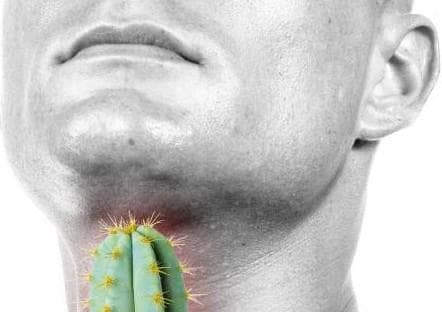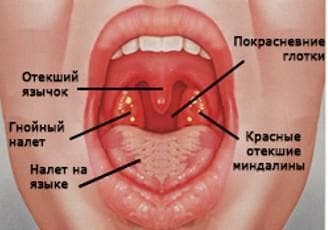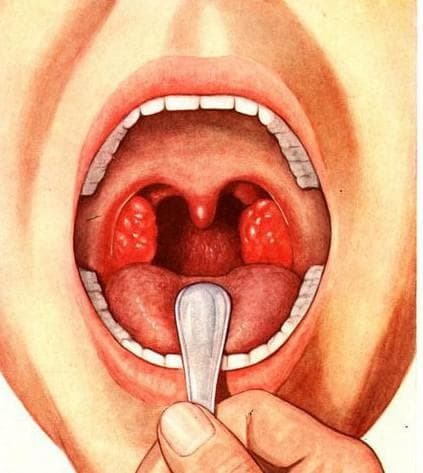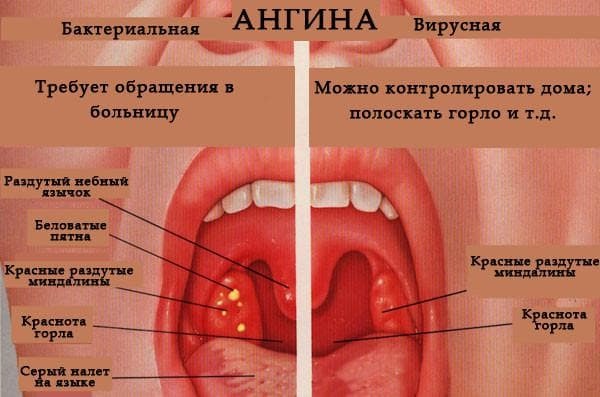
A complex infectious disease of the tonsils, called "angina" is extremely common, therefore everyone who has somehow contacted the sick person is at risk. How much angina is contagious and whether there are measures to prevent this disease, we consider in our article.
Before giving an unambiguous answer, it should be clarified what kind of angina is involved. The variety of different strains of the virus and pathogenic microbes has spawned many different diseases, among which even the "classical" angina has several "relatives".
How is the treatment of herpes sore throat in children, you can find out by reading this article.
Contents
- 1 What you need to know
- 1.1 Purulent
- 1.2 Catarrhal
- 1.3 Viral
What you need to know
Types of angina can be classified according to the main feature - the causative agent of infection. Proper diagnosis is extremely important, because based on this information, you can prescribe treatment and give predictions. The disease can be divided into two large categories: bacterial and viral angina.

If you treat viral sore throat with antibiotics, you can not wait for the effect, while the internal organs of the already attacked viruses will also have all the "benefits" of medications. The same is true of bacterial angina: antiviral treatment will not affect the number of microbes in any way, and precious time will be lost.
What can be the causes of herpes sore throat in children, indicated in the description for this article.
Do not treat the sore throat simply does not work, the infection will continue to spread, causing many life-threatening injuries. The consequences of improper treatment or prolonged angina may be the most deplorable, up to a lethal outcome. There is always a question of how contagious angina is, what period, but it all depends on the intensity of the treatment.
To prevent this, the enemy must be carefully studied, finding out the cause and possible weaknesses. Knowing exactly which angina you or your loved ones can accurately determine the degree of infectiousness and possible preventive measures.
How to treat necrotizing angina, you can learn from this article.
In the video it is told if the sore throat is contagious or not:
How is treatment of sore throat with Sumamed is indicated in this article.
Purulent
Probably the most unpleasant and difficult to treat, this is purulent angina. A characteristic feature that gave it the name will be a purulent plaque on the throat and tonsils. It is caused by groups of streptococci and staphylococci. 
Types of purulent angina:
- Lacunar : tonsil canals, called lacunae are filled with pus. It is easier to treat than follicular, less complications and the duration of the disease. If you neglect treatment, this form of angina will easily pass into the follicular or phlegmonous.
- Follicular : purulent eruptions are located on the follicles of the tonsils. The blood vessels of the tonsils are too close to the surface, so the risk of infection is higher throughout the body. A large percentage of complications, general intoxication of the body and strong pain, often spreading to the ears and nasopharynx.
- Phlegmonous : the most dangerous when purulent discharge completely captures one of the tonsils. This is a dangerous condition requiring immediate hospitalization and surgical intervention( removal of the infected amygdala or two at once).
From this article you can find out what to gargle with purulent sore throat.
The video tells you if the sore throat is contagious:
How is prophylaxis of angina in children, you can read in the article.
Treatment with antibiotics, exclusively bed rest( complications are often associated with the transfer of the disease "on legs"), good nutrition without provoking factors, complete rejection of bad habits and additional activities. All kinds of rinses, compresses and all household remedies should be applied only after consultation with the doctor.
The patient will be infectious during the entire period of the illness, the greatest risk with personal contact and through hygiene items. The incubation period is 1-2 days. The danger of purulent sore throat is not only in difficult treatment, but also a high risk of complications. The characteristic consequences of the transferred purulent sore throat are the development of rheumatism, worsening of the heart and vascular system, kidney disease, meningitis and sepsis.
As an exciter of sore throat can enter the body, it is indicated in this article.
Catarrhal
One of the lightest forms of angina, caused also by the family of cocci, manifests itself in unfavorable weather conditions and with reduced immunity. The main routes of infection are airborne, the treatment also takes into account the use of antibiotics and local procedures: rinses, lotions and lubrication of affected areas with disinfectant mixtures. Often occurs without a significant increase in temperature, so it can be in time not diagnosed or mistaken for a common cold. This contributes to infecting other people and improper treatment. The patient is infectious during the whole period of the illness, but the first three days are especially dangerous. 
Viral
As already seen from the name, the main pathogens of the disease are different strains of viruses. Symptoms are similar in many respects to catarrhal infection, but antibiotic treatment in this case does not have an effect. Especially often there is a viral sore throat in the winter time, has the character of an epidemic and is transmitted mainly by airborne droplets. 
One form of viral sore throat is the herpes form. This is an extremely dangerous disease, only in 5% of cases caused by herpesviruses. Most often you can find another reason - Coxsackie viruses and echoviruses. This disease is most dangerous for young children, but fortunately, can not manifest repeatedly due to antibodies developed in the body during the first time.
How correctly and in what dosages it is necessary to use Chlorophyllipt in angina is indicated in this article.
The incubation period of viral angina is from 2 days to 2 weeks. How many days is the disease contagious? Especially contagious are the first five days of the active stage of the disease, but with proper treatment it passes.
Methods of transmission of infection:
- Air-drip is the most common method. It can be a conversation with a sick person, stay in one room and personal contact( for example, a kiss).Often outbreaks of infectious diseases affect whole groups: a group in the kindergarten, a class, a place of work. A good preventive measure will be personal hygiene and strengthening of immunity, as well as avoid as much as possible crowded places and public transport during the season of cold epidemics. In the room where the patient is, wet cleaning and regular airing. It will be superfluous and active vitaminization of other members of the family.
- Contact - when the infection is transmitted through utensils and common objects. A patient with angina is strongly recommended to temporarily use an individual set of dishes, towels, other items. It would be superfluous to "isolate" a toothbrush and even clothes from society. Bedding should be changed every two to three days and washed at maximum temperature. In addition to daily wet cleaning with a disinfectant, you can wipe the furniture surfaces, and furnishing details also with the appropriate solution.
- The alimentary method of will catch sore throat - this is infection through food. Usually the causative agent of the disease "hides" in dishes that have not undergone heat treatment. Dairy and meat products are also extremely attractive for pathogens and viruses, so it is better not to risk eating in dubious establishments or negligently disturbing the technological process of cooking.
- The autoinfection of , in which danger is the dormant inside of each chronic inflammatory process. To infect an angina without someone's help is quite possible, if there are problems with the teeth, chronic diseases of the nasopharynx( tonsillitis, sinusitis).The trigger button for the further spread of microbes will be a decrease in immunity or accompanying ailments. It is possible to avoid this and simply improve your health by regularly observing and curing all problematic issues.
For what reason can sore throat without fever and sore throat, indicated in the article.
On the video - Dr. Komarovsky tells whether the sore is transmitted by airborne droplets:
How is treatment of angina Amoxiclave, you can find out by reading this article.
The best prevention will avoid any contact with sick people, strengthen their immunity and in time to treat chronic diseases, and also observe the rules of personal hygiene and rational nutrition. If care is needed for a family member who is ill, simple precautions can help avoid further spread of the disease. This is temporary isolation of the patient, regular airing of the room, daily disinfecting cleaning and vitaminization of the rest of the family. The barrier methods of protection are good: a cotton-gauze bandage with a timely treatment can well withstand the infection.
Do not be at risk to infect yourself and loved ones with this disease, despite the prevalence, angina is an extremely insidious and contagious disease, the consequences of which are difficult to predict.
A few facts about the infectiousness of angina from Dr. Komarovsky:
- The incubation period of the disease is only 1-5 days, depending on the nature of the pathogen. If, after contact with the sick, it took at least a week, you can not be afraid to pick up the baton.
- With the airborne drinking of infection, the sick person already on the fifth day ceases to be dangerous to others. Just in case, you can withstand the standard seven days, and then remove the home quarantine.
- Approximately on the fourth - fifth day of illness, under condition of adequate treatment, the patient feels much better and mistakenly believes that the disease is behind. Refusal to continue taking medications can lead to repeated infection and aggravation of sore throat.
- Throughout the treatment, even after the disappearance of the main symptoms, the patient is contagious to others. On average, the course of treatment of angina is from 5 to 14 days.
- The most dangerous and infectious period: 3-5 days of disease progression. The causative agents are able to spread within a radius of two meters, so it is highly recommended to isolate the patient into a separate room or, conversely, temporarily relocate to relatives, leaving one person to take care of the sick.
The video tells how the viral sore throat is transmitted:
Angina is an extremely dangerous and serious disease that can cause serious complications. A sick person not only puts his body at risk, but also a danger to others. All kinds of angina are very contagious, therefore, and there are whole outbreaks of epidemics in closed collectives. The best way to protect yourself and loved ones will be simple recommendations for prevention.
Angina necessarily requires proper treatment, and it can not be cured exclusively by domestic means, it is better to supplement them with officially prescribed medications.
